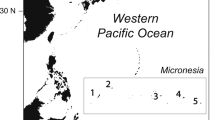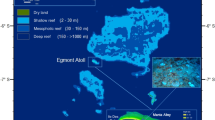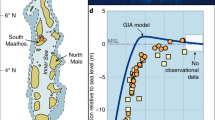Abstract
In 1998, more than 90% of shallow corals were killed on most Indian Ocean reefs1. High sea surface temperature (SST) was a primary cause2,3, acting directly or by interacting with other factors3,4,5,6,7. Mean SSTs have been forecast to rise above the 1998 values in a few decades2,3; however, forecast SSTs rarely flow seamlessly from historical data, or may show erroneous seasonal oscillations, precluding an accurate prediction of when lethal SSTs will recur. Differential acclimation by corals in different places complicates this further3,7,8. Here I scale forecast SSTs at 33 Indian Ocean sites where most shallow corals died in 1998 (ref. 1) to identify geographical patterns in the timing of probable repeat occurrences. Reefs located 10–15° south will be affected every 5 years by 2010–2025. North and south from this, dates recede in a pattern not directly related to present SSTs; paradoxically, some of the warmest sites may be affected last. Temperatures lethal to corals vary in this region by 6 °C, and acclimation of a modest 2 °C by corals could prolong their survival by nearly 100 years.
This is a preview of subscription content, access via your institution
Access options
Subscribe to this journal
Receive 51 print issues and online access
$199.00 per year
only $3.90 per issue
Buy this article
- Purchase on Springer Link
- Instant access to full article PDF
Prices may be subject to local taxes which are calculated during checkout





Similar content being viewed by others
References
Wilkinson, C. R. in Seas at the Millennium, an Environmental Evaluation vol. 3 (ed. Sheppard, C.) 43–57 (Elsevier, Amsterdam, 2000)
Hoegh-Guldberg, O. Climate change, coral bleaching and the future of the world's coral reefs. Mar. Freshwater Res. 50, 839–866 (1999)
Pittock, A. B. Coral reefs and environmental change: Adaptation to what? Am. Zool. 39, 10–29 (1999)
Turner, J., et al. in Coral Reef Degradation in the Indian Ocean, Status Report 2000 (eds Souter, D., Obura, D. & Linden, O.) 94–107 (CORDIO, Stockholm, 2000)
Nakamura, T. & Woesik, R. Water-flow rates and passive diffusion partially explain differential survival during the 1998 bleaching event. Mar. Ecol. Prog. Ser. 212, 301–304 (2001)
Sheppard, C. R. C. The main issues affecting coasts of the Indian and western Pacific Oceans: a meta-analysis from seas at the millennium. Mar. Pollut. Bull. 42, 1199–1207 (2001)
Douglas, A. W. Coral bleaching—how and why? Mar. Pollut. Bull. 46, 385–392 (2003)
Gates, R. D. & Edmunds, P. J. The physiological mechanisms of acclimatisation in tropical reef corals. Am. Zool. 39, 30–43 (1999)
Wilkinson, C. R. et al. Ecological and socio-economic impacts of 1998 coral mortality in the Indian Ocean: an ENSO (El Niño-Southern Oscillation) impact and a warning of future change? Ambio 28, 188–196 (1999)
Cesar, H. S. J. (ed.) Economics of Coral Reefs 244 (CORDIO, Kalmar, Sweden, 2000)
Rayner, N. A. et al. Global analyses of SST, sea ice and night marine air temperature since the late nineteenth century. J. Geophys. Res. Atmos. (in the press)
Sheppard, C. R. C. & Rayner, N. Utility of the Hadley Centre sea ice and surface temperature data set (HadISST1) in two widely contrasting coral reef areas. Mar. Pollut. Bull. 44, 303–308 (2002)
McAvaney, B. J. et al. Climate Change 2001: The Scientific Basis. Intergovernmental Panel on Climate Change (ed. Houghton, J. T. et al.) 471–523 (Cambridge Univ. Press, Cambridge, UK, 2001)
Cubasch, U. et al. Climate Change 2001: The Scientific Basis. Intergovernmental Panel on Climate Change (ed. Houghton, J. T. et al.) 525–582 (Cambridge University Press, Cambridge, UK, 2001)
Sheppard, C. R. C. & Loughland, R. Coral mortality and recovery in response to increasing temperature in the southern Arabian Gulf. Aquat. Ecosyst. Health Mgmt 5, 395–402 (2002)
Veron, J. E. N. Corals of the World vols 1–3 (Australian Institute of Marine Science, Townsville, Australia, 2000)
Sheppard, C. R. C. & Sheppard, A. L. S. Corals and coral communities of Arabia. Fauna Saudi Arabia 12, 7–192 (1991)
Sheppard, C. R. C., Spalding, M., Bradshaw, C. & Wilson, S. Erosion vs. recovery of coral reefs after 1998 El Niño: Chagos reefs, Indian Ocean. Ambio 31, 40–48 (2002)
Linden, O., Souter, D., Wilhemsson, D. & Obura, D. Coral Reef Degradation in the Indian Ocean, Status Report 2002 284 (CORDIO, Kalmar, Sweden, 2002)
Riegl, B. Effects of the 1996 and 1998 positive sea-surface temperature anomalies on corals, coral diseases and fish in the Arabian Gulf (Dubai, UAE). Mar. Biol. 140, 29–40 (2002)
McClanahan, T. R. Bleaching damage and recovery potential of Maldivian coral reefs. Mar. Pollut. Bull. 40, 587–597 (2000)
Spencer, T., Teleki, K. A., Bradshaw, C. & Spalding, M. D. Coral bleaching in the southern Seychelles during the 1997–1998 Indian Ocean warm event. Mar. Pollut. Bull. 40, 569–586 (2000)
Harrison, P. L. & Wallace, C. C. in Coral Reefs (ed. Dubinsky, Z.) 133–206 (Elsevier, Amsterdam, 1990)
Sheppard, C. R. C. & Salm, R. V. Reefs and corals of Oman, with a description of a new species of coral (Scleractinia, Acanthastrea). J. Nat. Hist. 22, 263–279 (1988)
Acknowledgements
The HadCM3 data were provided by the Hadley Centre for Climate Research through D. Viner, who also provided information on the data's characteristics. I thank M. Keeling and G. Medley for advice on analyses; N. Rayner of the Hadley Centre for information on the HadISST1 data and for communicating results before publication; and O. Langmead and A. Edwards for assistance with data extraction.
Author information
Authors and Affiliations
Ethics declarations
Competing interests
The author declares that he has no competing financial interests.
Supplementary information
Rights and permissions
About this article
Cite this article
Sheppard, C. Predicted recurrences of mass coral mortality in the Indian Ocean. Nature 425, 294–297 (2003). https://doi.org/10.1038/nature01987
Received:
Accepted:
Issue Date:
DOI: https://doi.org/10.1038/nature01987
This article is cited by
-
Tropical coral reefs in Sri Lanka are threatened due to the fluctuation of seasonal and interannual sea surface temperature
Environmental Monitoring and Assessment (2023)
-
Relationship between coral bleaching and large-scale oscillations in the Lakshadweep archipelago
Ocean Dynamics (2023)
-
Climatic and tectonic drivers shaped the tropical distribution of coral reefs
Nature Communications (2022)
-
Contrasting shifts in coral assemblages with increasing disturbances
Coral Reefs (2020)
-
A global analysis of coral bleaching over the past two decades
Nature Communications (2019)
Comments
By submitting a comment you agree to abide by our Terms and Community Guidelines. If you find something abusive or that does not comply with our terms or guidelines please flag it as inappropriate.



